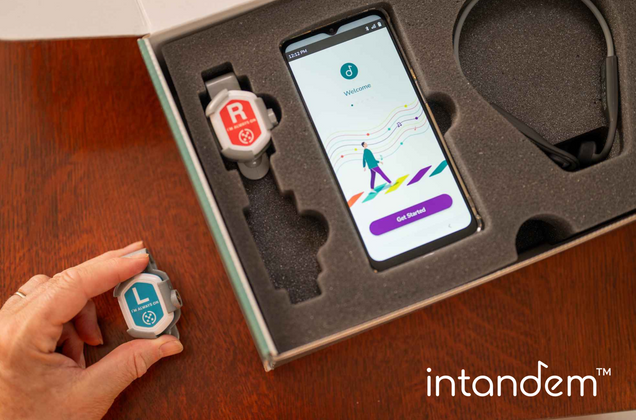Music and Rhythm-based Technology Helps Stroke Survivors Improve Walking Ability in Nationwide Clinical Trial
 Pivotal clinical trial achieved primary endpoint: Use of InTandemTM neurorehabilitation system resulted in a clinically meaningful and significant increase in walking speed for stroke survivors
Pivotal clinical trial achieved primary endpoint: Use of InTandemTM neurorehabilitation system resulted in a clinically meaningful and significant increase in walking speed for stroke survivors- Compared to an Active Control, individuals randomized to InTandem were three times more likely to be responders
Nearly 800,000 Americans experience a stroke each year, making it a leading cause of disability. One common condition after a stroke is hemiparesis – muscle weakness or partial paralysis – which can make movement slower and more difficult. Walking, and in particular independent walking outside the home, poses a significant challenge for as many as 85 percent of stroke survivors. This leads individuals to walk more slowly which is associated with increased comorbidities and fall risk, negatively affecting both their health and quality of life.
Improving the walking ability of chronic stroke survivors is a major public health concern, and more effective and widely available interventions are crucially needed.
One such intervention uses the power of rhythm and music to automatically entrain motor responses to facilitate improved walking. InTandemTM is an FDA-authorized prescription neurorehabilitation system which autonomously delivers individualized and progressive rhythmic auditory stimulation.
Findings from a clinical trial featured this month in Nature Communications demonstrate that InTandem has the potential to close the gap in both efficacy and access which can currently limit recovery of walking ability.

“Walking speed is widely thought of as the functional vital sign; slow walking is associated with reduced health and quality of life,” said the trial’s principal investigator Lou Awad, associate professor of physical therapy and director of the Neuromotor Recovery Lab at Boston University Sargent College of Health & Rehabilitation Sciences. “But faster walking can sometimes come at the cost of gait quality. There are few interventions that can help people with chronic stroke gait impairment improve both their gait speed and quality. InTandem’s use of auditory-motor entrainment to deliver an individualized intervention, has shown a remarkable ability to improve walking speed, reduce gait asymmetry, and make walking after stroke ultimately less effortful and more stable.”
The multi-site randomized clinical trial was conducted at eight major rehabilitation hospitals and research institutions across the U.S., including the Shirley Ryan AbilityLab, Spaulding Rehabilitation, Boston University Sargent College, Kessler Foundation, Mount Sinai Health System, Atrium Health, Johns Hopkins, and The University of North Carolina at Chapel Hill.
In the trial, individuals in the chronic phase of stroke recovery were randomly assigned to InTandem or an active control group. Both groups were asked to complete three, thirty-minute walking sessions each week for five weeks. At the conclusion of the trial, participants randomized to InTandem demonstrated statistically significant increases in walking speed (Δ: 0.14±0.03 m/s) as compared to Active Control (Δ: 0.06±0.02 m/s) (F(1,49)=6.58, p=0.013). There was no statistical difference in safety events between InTandem users and the control.
“Stroke can significantly impact a person’s ability to walk, putting them at greater risk for falls, other health conditions and poorer quality of life,” said Paolo Bonato, PhD, adjunct associate professor of physical therapy at Sargent College and director of the Motion Analysis Lab at Spaulding Rehabilitation. “Our trial shows that an intervention applying algorithmically-controlled music as a rhythmic stimulus improves walking and ambulation by inciting and harnessing the unconscious synchronization of the auditory and motor systems.”
InTandem is a neurorehabilitation system developed by MedRhythms and studied in collaboration with physical therapy researchers and clinicians at Boston University Sargent College of Health & Rehabilitation. The InTandem system includes a touchscreen control unit with preloaded proprietary treatment algorithms, a headset, and two sensors worn on the users’ shoes. The technology improves walking for individuals in the chronic phase of stroke recovery via autonomous delivery of Rhythmic Auditory Stimulation, a clinical intervention that targets automatic processes in the brainstem, cerebellum, and spinal cord to induce auditory-motor entrainment—the unconscious synchronization of the auditory and motor systems. Notably, InTandem takes a personalized approach and automatically adjusts the music-based rhythmic cues in response to each individual’s particular gait characteristics in real time.
“This cumulative evidence is an important step forward in our mission to improve health outcomes for stroke survivors,” said Brian Harris, MedRhythms CEO and co-founder. “These results confirm InTandem’s safety and efficacy for home use by patients living with gait impairment in the chronic stroke recovery phase. This evidence forms the most critical foundation for making a meaningful impact on patients’ everyday lives.”
Prior to the multi-center randomized clinical trial, two feasibility studies were conducted in 2020. The first showed clinically meaningful gains in walking speed after just one session using the system while the second showed a reduction in gait asymmetry and improvement in gait efficiency, also after just one session.
Awad and MedRhythms will present the full results of the clinical trial at the American Physical Therapy Association Combined Sections Meeting in February.